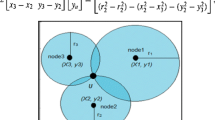Abstract
The use of Received Signal Strength Indicator (RSSI), obtained automatically with the received messages in most sensor radios, is a popular way for estimating the location of a mobile wireless object. The great variation of Received Signal Strength (RSS), which may result in inaccurate estimations, is compensated by the fact that RSS does not require any additional hardware, and may reduce the sensor node power consumption, size and cost. The present work investigates the impact of variety of parameters on RSS by experimenting with Tmote Sky nodes in real-field outdoor environments. Besides the operating frequency, the transmitter–receiver distance, the variation of transceivers, the antenna orientation, and the environment specifics were found as important factors for creating accurate models, which would serve in tracking and localization applications.
Similar content being viewed by others
References
Savvides, A., Han, C., & Srivastava, M. B. (2001). Dynamic fine-grained localization in ad-hoc networks of sensors. In MobiCom 2001 (pp. 166–179). Rome, Italy.
He, T., Huang, C., Blum, B. M., Stankovic, J. A., & Abdel-Zaher, T. (2003). Range-free localization schemes for large scale sensor networks. In MobiCom 2003 (pp. 81–95). San Diego, CA, September 2003.
Reichenbach, F., Blumenthal, J., & Timmermann, D. (2006). Improved precision of coarse grained localization in wireless sensor networks. In 9th conference DSD 2006 (pp. 630–637). Dubrovnik, Croatia, September 2006.
Niculescu, D., & Nath, B. (2003). DV based positioning in ad hoc networks. Journal of Telecommunication Systems, 22(1), 267–280.
Hu, L., & Evans, D. (2004). Localization for mobile sensor networks. In ACM MobiCom ’04 (pp. 45–57). Philadelphia, US.
Sichitiu, M. L., Ramadurai, V., & Peddabachagari, P. (2003). Simple algorithm for outdoor localization of wireless sensor networks with inaccurate range measurements. In Int. conference on wireless networks (ICWN 2003) (pp. 300–305). Las Vegas, NV, June 2003.
Smith, A., Balakrishnan, H., Goraczko, M., & Priyantha, N. (2004). Tracking moving devices with the cricket location system. In ACM MobiSys’04 (pp. 190–202). Boston, MA.
Lorincz, K., & Welsh, M. (2006). MoteTrack: A robust, decentralized approach to RF-based location tracking. In Proceedings of personal and ubiquitous computing, special issue on location and context-awareness. Berlin: Springer.
He, T., Krishnamurthy, S., Luo, L., Yan, T., Gu, L., Stoleru, R., Zhou, G., Cao, Q., Vicaire, P., Stankovic, J. A., Abdelzaher, T. F., Hui, J., & Krogh, B. (2006). VigilNet: An integrated sensor network system for energy-efficient surveillance. ACM Transactions on Sensor Networks, 2(1), 1–38.
Arora, A., Dutta, P., Bapat, S., Kulathumani, V., Zhang, H.-W., Naik, V., Mittal, V., Cao, H., Demirbas, M., Gouda, M., Choi, Y. R., Herman, T., Kulkarni, S., Arumugam, U., Nesterenko, M., Vora, A., & Miyashita, M. (2004). A line in the sand: A wireless sensor network for target detection, classification, and tracking. Computer Networks. 46(5), 605–634.
Bahl, P., Balachandran, A., & Padmanabhan, V. (2000). Enhancements to the RADAR user location and tracking system. Technical Report, MSR.
Yedavalli, K., Krishnamachari, B., Ravula, S., & Srinivasan, B. (2005). Ecolocation: A technique for rf based localization in wireless sensor networks. In IPSN 2005, Los Angeles, CA.
Stoleru, R., & Stankovic, J. A. (2004). Probability grid: A location estimation scheme for wireless sensor networks. In IEEE international conference on sensor and ad-hoc communications and networks (SECON), Santa Clara, CA.
Ma, J., Chen, Q., Zhang, D., & Ni, L. M. (2006). An empirical study of radio signal strength in sensor networks using MICA2 nodes. HKUST, Technical Report.
Lee, E. F., Wang, C., & Xiao, L. (2006). A study of radio signal behaviors in complex environments. Computer Science Department, Michigan State University, Technical Report MSU-CSE-06-6, Michigan.
Lymberopoulos, D., Lindsey, Q., & Savvides, A. (2006). An empirical analysis of radio signal strength variability in IEEE 802.15.4 networks using monopole antennas. ENALAB Technical Report 050501, EWSN.
Tseng, Y. C., Kuo, S. P., Lee, H. W., & Huang, C. F. (2003). Location tracking in a wireless sensor network by mobile agents and its data fusion strategies. In Int. workshop on IPSN’03 (Vol. 2634, pp. 625–641). Palo Alto CA.
Rappaport, T. S. (2001). Wireless communications: Principles and practice (2nd ed.). New York: Prentice Hall.
Anderson, H. R. (2003). Fixed broadband wireless system design, New York: Wiley. ISBN:0-470-84438-8.
Siwiak, K. (1998). Radiowave propagation and antenna for personal communications (2nd ed.). Norwood: Artech House.
Ultra low power IEEE 802.15.4 compliant wireless sensor module. Tmote Sky datasheet, Moteiv Corporation Inc. (2006).
Anderson, A. (2007). 2.4 GHz inverted-F antenna. Design note DN0007, Texas Instruments.
Author information
Authors and Affiliations
Corresponding author
Additional information
The work reported here was performed as part of the ongoing research Program uSWN FP6-2005 IST-034642 and funded by the European Social Fund (ESF).
Rights and permissions
About this article
Cite this article
Stoyanova, T., Kerasiotis, F., Prayati, A. et al. Evaluation of impact factors on RSS accuracy for localization and tracking applications in sensor networks. Telecommun Syst 42, 235 (2009). https://doi.org/10.1007/s11235-009-9183-8
Published:
DOI: https://doi.org/10.1007/s11235-009-9183-8




